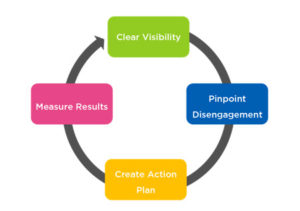4 steps to a winning employee engagement strategy
Watch the webinar “Build a Winning Employee Engagement Strategy.”
Steve Jobs once said that he was just as proud of the things he hadn’t done as the things he had. He meant that in order to achieve true focus on the things he was trying to accomplish, he had to say no to 1,000 other things along the way.
That’s strategy.
In much the same way, you may be trying to accomplish too much with your company culture by going after a number of initiatives instead of a focused list that will lead to the greatest outcomes. How can you pick the best, highest ROI-yielding culture initiatives to say “yes” to?
One thing’s for sure—it’s not done by simply trusting your gut. Whereas every other area of your business is meticulously measured (think sales metrics and finance projections), the engagement of your employees (your greatest asset) is often left to a hunch instead of actual objective data.
In the tech world, the concept of agile methodology has been the hero of many development teams, keeping them nimble and on-track to achieve their goals. By applying this concept to employee engagement (what I like to call “agile engagement” in my book of the same name), organizations can finally achieve the employee engagement they’ve been waiting for with a strategy that’s based on actual data, actionable goals, and iteration.

1. See clearly through data
Business legend Peter Drucker has been credited as saying “you can’t improve what you can’t measure.” Never has that been more true than with employee engagement. But human emotion isn’t an easy thing to measure, which is why gaining clear visibility into your employee engagement levels takes expert planning by asking the right questions, reaching the right people (whether in-office or remote), and following up on a regular cadence.
2. Diagnose problem areas
Take a look at your current employee survey methods. Are you measuring for true engagement or just for employee satisfaction and happiness? (Hint: An engaged employee can’t wait to come to work. A satisfied employee can’t wait to go home.) The way you can tell is by asking the right questions that are based on the psychological conditions of engagement (meaning, safety, capacity) and breaking the results down into employee groups like department, team, role, or level of tenure. Doing this will help you pinpoint the exact areas of the business to focus on instead of blitzing the entire company with engagement tactics that may or may not work.
3. Prioritize focused action
As you identify the areas of the business that have the lowest levels of engagement, document a prioritized strategy that includes action items, timebound goals, and ownership of each initiative. Doing this will keep you laser-focused on the most important areas for improvement that will make the greatest impact.
4. Continuously measure results
True employee engagement isn’t something you can just check off a list and be done with. Like your other business functions, it is ongoing and requires regular nurturing. That’s why the agile engagement process advocates for a combination of ongoing surveys and polls to help you keep a pulse on your engagement levels even after “the big annual survey” is done. By asking short questions that employees can quickly respond to, you can probe further into your “problem areas” of engagement and get the answers you need to take action instead of waiting until another large-scale survey goes out.
If you have a hunch that employee engagement at your organization could use a wake-up call but don’t have the objective data to back it up, it’s time to implement agile employee engagement. Read on by downloading the first chapter of the Agile Engagement book for free.
Read more on this topic: A simple approach to an engaged workforce
Category: Talent Management
Tags: Emplify, Employee Engagement, engaged employees, Fridays with Vistage Webinars, NationalSponsor, Webinar, Workplace Culture

